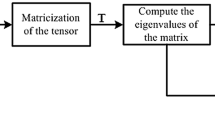Abstract
This paper deals with estimation of structured signals such as damped sinusoids, exponentials, polynomials, and their products from single channel data. It is shown that building tensors from this kind of data results in tensors with hidden block structure which can be recovered through the tensor diagonalization. The tensor diagonalization means multiplying tensors by several matrices along its modes so that the outcome is approximately diagonal or block-diagonal of 3-rd order tensors. The proposed method can be applied to estimation of parameters of multiple damped sinusoids, and their products with polynomial.
The work of P. Tichavsky was supported by The Czech Science Foundation through Projects No. 14-13713S and 17-00902S.
Access this chapter
Tax calculation will be finalised at checkout
Purchases are for personal use only
Similar content being viewed by others
Notes
- 1.
The NLS algorithm is available in the Tensorlab toolbox at www.tensorlab.net.
References
Cichocki, A., Zdunek, R., Phan, A.-H., Amari, S.: Nonnegative Matrix and Tensor Factorizations: Applications to Exploratory Multi-way Data Analysis and Blind Source Separation. Wiley, Chichester (2009)
Cichocki, A., Mandic, D., Caiafa, C., Phan, A.-H., Zhou, G., Zhao, Q., Lathauwer, L.D.: Multiway component analysis: tensor decompositions for signal processing applications. IEEE Sig. Process. Mag. 32(2), 145–163 (2015)
Comon, P., Jutten, C. (eds.): Handbook of Blind Source Separation: Independent Component Analysis and Applications. Academic Press, Cambridge (2010)
Proakis, J., Manolakis, D.: Digital Signal Processing: Principles, Algorithms, Applications. Macmillan, London (1992)
Kumaresan, R., Tufts, D.: Estimating the parameters of exponentially damped sinusoids and pole-zero modelling in noise. IEEE Trans. Acoust. Speech Sig. Proces. 30(7), 837–840 (1982)
Hua, Y., Sarkar, T.: Matrix pencil method for estimating parameters of exponentially damped/undamped sinusoid in noise. IEEE Trans. Acoust. Speech Sig. Process. 38(5), 814–824 (1990)
Papy, J.M., De Lathauwer, L., Van Huffel, S.: Exponential data fitting using multilinear algebra: the single-channel and the multichannel case. Numer. Linear Algebra Appl. 12(9), 809–826 (2005)
Nion, D., Sidiropoulos, N.D.: Tensor algebra and multidimensional harmonic retrieval in signal processing for MIMO radar. IEEE Trans. Sig. Process. 58, 5693–5705 (2010)
Wen, F., So, H.C.: Robust multi-dimensional harmonic retrieval using iteratively reweighted HOSVD. IEEE Sig. Process. Lett. 22, 2464–2468 (2015)
Sørensen, M., De Lathauwer, L.: Multidimensional harmonic retrieval via coupled canonical polyadic decomposition - Part 1: model and identifiability. IEEE Trans. Sig. Process. 65(2), 517–527 (2017)
De Lathauwer, L.: Blind separation of exponential polynomials and the decomposition of a tensor in rank-(\(L_r\),\(L_r\),1) terms. SIAM J. Matrix Anal. Appl. 32(4), 1451–1474 (2011)
De Lathauwer, L.: Block component analysis, a new concept for blind source separation. In: Proceedings of the 10th International Conference on LVA/ICA, Tel Aviv, 12–15 March, pp. 1–8 (2012)
Tichavský, P., Phan, A.-H., Cichocki, A.: Tensor diagonalization-a new tool for PARAFAC and block-term decomposition (2014). arXiv preprint arXiv:1402.1673
Kouchaki, S., Sanei, S.: Tensor based singular spectrum analysis for nonstationary source separation. In: Proceedings of the 2013 IEEE International Workshop on Machine Learning for Signal Processing, Southampton, UK (2013)
Debals, O., Lathauwer, L.: Stochastic and deterministic tensorization for blind signal separation. In: Vincent, E., Yeredor, A., Koldovský, Z., Tichavský, P. (eds.) LVA/ICA 2015. LNCS, vol. 9237, pp. 3–13. Springer, Heidelberg (2015). doi:10.1007/978-3-319-22482-4_1
Boussé, M., Debals, O., De Lathauwer, L.: A tensor-based method for large-scale blind source separation using segmentation. IEEE Trans. Sig. Process. 65(2), 346–358 (2017)
Cichocki, A., Namgil, L., Oseledets, I., Phan, A.-H., Zhao, Q., Mandic, D.P.: Tensor networks for dimensionality reduction and large-scale optimization. Found. Trends\(\textregistered \) Mach. Learn. 9(4–5) (2017)
Sorber, L., Van Barel, M., De Lathauwer, L.: Structured data fusion. IEEE J. Sel. Top. Sign. Proces. 9(4), 586–600 (2015)
Hayes, M.: Statistical Digital Signal Processing and Modeling. Wiley, Hoboken (1996)
Author information
Authors and Affiliations
Corresponding author
Editor information
Editors and Affiliations
A Appendix: Low-Rank Representation of the Sequence \(x(t) = t^n\)
A Appendix: Low-Rank Representation of the Sequence \(x(t) = t^n\)
Lemma 5
(Three-way folding of \(x(t) = t\) ). An order-3 tensor of size \(I\times J\times K\), reshaped (folded) from the sequence \(1,2,\ldots , IJK\), where \(I,J,K>2\), has multilinear rank-(2, 2, 2) and rank-3, and can be represented as
where \(\varvec{\mathscr {\MakeUppercase {G}}}\) is a tensor of size \(2 \times 2 \times 2\)
and the three factor matrices are given by
Lemma 6
(Toeplitzation of \(x(t) = t\) ). An order-3 Toeplitz tensor of size \(I\times J\times K\), tensorized from the sequence \(1,2,\ldots , L\), where \(L = I+J+K-2\), has multilinear rank-(2, 2, 2) and rank-3, and can be represented as
where \(\varvec{\mathscr {\MakeUppercase {G}}}\) is a tensor of size \(2 \times 2 \times 2\)
and the three factor matrices are given by
Lemma 7
(Three-way folding of \(x(t) = t^n\) ). An order-3 tensor of size \(I\times J\times K\), reshaped (folded) from the sequence \(x(t) = t^n\), where \(n = 1, 2, \ldots \) and \(I,J,K>2\), has multilinear rank-(\(n+1,n+1,n+1\)).
Proof
By exploiting the closed-form expression of \(x(t) = t\) in Lemma 5, and the property of the Hadamard product stated in Lemma 4 or in (13), we can prove that the tensor reshaped from \(x(t) = t^n\) can be fully explained by three factor matrices which have \(n+1\) columns, and are defined as \(\mathbf{U}_1 = \mathbf{F}(I,n)\), \(\mathbf{U}_2 = \mathbf{F}(IJ,n)\) and \(\mathbf{U}_3 = \mathbf{F}(IJK,n)\), where
\(\square \)
Lemma 8
(Toeplitzation of \(x(t) = t^n\) ). An order-3 Toeplitz tensor of size \(I\times J\times K\) of the sequence \(x(t) = t^n\), has multilinear rank-(\(n+1,n+1,n+1\)).
Proof
Skipped for lack of space.
\(\square \)
Rights and permissions
Copyright information
© 2017 Springer International Publishing AG
About this paper
Cite this paper
Phan, AH., Tichavský, P., Cichocki, A. (2017). Blind Source Separation of Single Channel Mixture Using Tensorization and Tensor Diagonalization. In: Tichavský, P., Babaie-Zadeh, M., Michel, O., Thirion-Moreau, N. (eds) Latent Variable Analysis and Signal Separation. LVA/ICA 2017. Lecture Notes in Computer Science(), vol 10169. Springer, Cham. https://doi.org/10.1007/978-3-319-53547-0_4
Download citation
DOI: https://doi.org/10.1007/978-3-319-53547-0_4
Published:
Publisher Name: Springer, Cham
Print ISBN: 978-3-319-53546-3
Online ISBN: 978-3-319-53547-0
eBook Packages: Computer ScienceComputer Science (R0)




